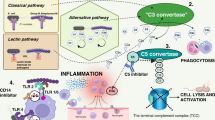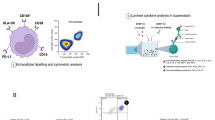Abstract
Neonatal bacterial sepsis is often characterized by a fulminant clinical course and highly elevated plasma levels of proinflammatory cytokines. To evaluate in vitro activation of the neonatal immune system by specific infectious stimuli, cord blood cells from healthy neonates were examined for expression of tumor necrosis factor-α (TNF-α), IL-1β, IL-6, and IL-8 in response to Streptococcus agalactiae (GBS), lipopolysaccharide (LPS), and lipoteichoic acid (LTA). Cytokine-expression was compared in mononuclear cells from cord and adult peripheral blood. TNF-α and IL-6 levels in the supernatant of cord blood cell cultures were significantly higher after stimulation with heat-killed GBS (107/mL) than with LPS (2 μg/mL) or LTA (2 μg/mL) (TNF-α: 2215 versus 267.5 versus 40 pg/mL, p = 0.001; IL-6: 9667 versus 4909 versus 919 pg/mL, p = 0.006). mRNA expression of TNF-α, IL-1β, IL-6, and IL-8 was equally pronounced after stimulation with either GBS, LPS, or LTA in cord or adult blood cells at various times. A MAb directed against the monocyte receptor molecule CD14 did not inhibit the release of cytokines in cord blood mononuclear cells after stimulation with GBS. In summary, activation of cord blood cells by infectious stimuli is comparable to the adult immune response in terms of expression of proinflammatory cytokines. GBS in particular proves to be a potent activator of the neonatal immune system when compared with LPS and LTA. CD14 seems not to be a crucial molecule for activation of cord blood cells by GBS.
Similar content being viewed by others
Log in or create a free account to read this content
Gain free access to this article, as well as selected content from this journal and more on nature.com
or
Abbreviations
- ABMNC:
-
adult blood mononuclear cells
- CBMNC:
-
cord blood mononuclear cells
- GBS:
-
group B streptococci
- HBSS:
-
Hanks' Balanced Salt Solution
- IFN-γ:
-
interferon-γ
- LPS:
-
lipopolysaccharide
- LTA:
-
lipoteichoic acid
- TNF-α:
-
tumor necrosis factor-α
References
Schrag SJ, Zywicki S, Farley MM, Reingold AL, Harrison LH, Lefkowitz LB, Hadler JL, Danila R, Cieslak PR, Schuchat A 2000 Group B streptococcal disease in the era of intrapartum prophylaxis. N Engl J Med 342: 15–20
Berner R, Schumacher RF, Bartelt S, Forster J, Brandis M 1998 Bacteremia in hospitalized children: predisposing conditions and case-related microorganisms. Eur J Clin Microbiol Infect Dis 17: 337–340
Gladstone IM, Ehrenkranz RA, Edberg SC, Baltimore RS 1990 A ten-year review of neonatal sepsis and comparison with the previous fifty-year experience. Pediatr Infect Dis J 9: 819–825
Cairo MS 1989 Neonatal neutrophil host defense. Am J Dis Child 143: 40–56
Chalmers IMH, Janossy G, Contreras M, Navarrete C 1998 Intracellular cytokine profile of cord and adult blood lymphocytes. Blood 92: 11–18
Lewis DB, Wilson CB 1995 Developmental immunology and role of host defenses in neonatal susceptibility to infection. In: Remington JS, Klein JO (eds) Infectious Diseases of the Fetus and Newborn Infant, 4th Ed. Saunders, Philadelphia, 20–99
Rowen JL, Smith CW, Edwards MS 1995 Group B streptococci elicit leukotriene B4 and interleukin-8 from human monocytes: neonates exhibit a diminished response. J Infect Dis 172: 420–426
Schibler KR, Liechty KW, White WL, Rothstein G, Christensen RD 1992 Defective production of interleukin-6 by monocytes: a possible mechanism underlying several host deficiencies of neonates. Pediatr Res 31: 18–21
Weatherstone K, Rich E 1989 Tumor necrosis factor/cachectin and interleukin-1 secretion by cord blood monocytes from premature and term neonates. Pediatr Res 25: 342–346
Yachie A, Takano N, Ohta K, Uehara T, Fujita S, Miyawaki T, Taniguchi N 1992 Defective production of IL-6 in very small premature infants in response to bacterial pathogens. Infect Immun 60: 749–753
Schultz C, Rott C, Richter N, Bucsky P, Reiss I, Gortner L 1999 Intracytoplasmic detection of cytokines in neonatal lymphocytes and monocytes by flow cytometry. Blood 93: 3566–3567
Scott ME, Kubin M, Kohl S 1997 High level interleukin-12 production, but diminished interferon-γ production, by cord blood mononuclear cells. Pediatr Res 41: 547–553
Vallejo JG, Baker CJ, Edwards MS 1996 Interleukin-6 production by human neonatal monocytes stimulated by type III group B streptococci. J Infect Dis 174: 332–337
Williams PA, Bohnsack JF, Augustine NH, Drummond WK, Rubens CE, Hill HR 1993 Production of tumor necrosis factor by human cells in vitro and in vivo, induced by group B streptococci. J Pediatr 123: 292–300
Berner R, Niemeyer CM, Leititis JU, Funke A, Schwab C, Rau U, Richter K, Tawfeek MSK, Clad A, Brandis M 1998 Plasma levels and gene-expression of G-CSF, TNF-α, IL-1β, IL-6, IL-8, and sICAM-1 in neonatal early-onset sepsis. Pediatr Res 44: 469–477
Berner R, Tüxen B, Clad A, Forster J, Brandis M 2000 Elevated gene-expression of interleukin-8 in cord blood is a sensitive marker of neonatal infection. Eur J Pediatr 159: 205–210
Ridge JP, Fuchs EJ, Matzinger P 1996 Neonatal tolerance revisited: turning on newborn T cells with dendritic cells. Science 271: 1723–1726
Sáez-Llorens X, McCracken GH 1992 Sepsis syndrome and septic shock in pediatrics: current concepts of terminology, pathophysiology, and management. J Pediatr 123: 497–508
Landmann R, Knopf HP, Link S, Sansano S, Schumann R, Zimmerli W 1996 Human monocyte CD14 is upregulated by lipopolysaccharide. Infect Immun 64: 1762–1769
Dunne DW, Resnick D, Greenberg J, Krieger M, Joiner KA 1994 The type I macrophage scavenger receptor binds to gram-positive bacteria and recognizes lipoteichoic acid. Proc Natl Acad Sci USA 91: 1863–1867
Bhakdi S, Klonisch T, Nuber P, Fischer W 1991 Stimulation of monokine production by lipoteichoic acids. Infect Immun 59: 4614–4620
Keller R, Fischer W, Keist R, Bassetti S 1992 Macrophage response to bacteria: induction of marked secretory and cellular activities by lipoteichoic acids. Infect Immun 60: 3664–3672
Sparwasser T, Miethke T, Lipford G, Erdmann A, Häcker H, Heeg K, Wagner H 1997 Macrophages sense pathogens via DNA motifs: induction of tumor necrosis factor-alpha-mediated shock. Eur J Immunol 27: 1671–1679
Dudley DJ, Edwin SS, van Wagones J, Augustine NH, Hill HR, Mitchell MD 1997 Regulation of decidual cell chemokine production by group B streptococci and purified bacterial cell wall components. Am J Obstet Gynecol 177: 666–672
von Hunolstein C, Totolian A, Alfrarone G, Mancusoa G, Cucumano V, Teti G, Orefici G 1997 Soluble antigens from group B streptococci induce cytokine production in human blood cultures. Infect Immun 65: 4017–4021
Kwak DJ, Augustine NH, Borges WG, Joyner JL, Green WF, Hill HR 2000 Intracellular and extracellular cytokine production by human mixed mononuclear cells in response to group B streptococci. Infect Immun 68: 320–327
Medvedev AE, Flo T, Ingalls RR, Golenbock DT, Teti G, Vogel SN, Espevik T 1998 Involvement of CD14 and complement receptors CR3 and CR4 in nuclear factor-B activation and TNF production induced by lipopolysaccharide and group B streptococcal cell walls. J Immunol 160: 4535–4542
Chomczynski P, Sacchi N 1987 Single-step method of RNA isolation by acid guanidium thiocyanate-phenol-chloroform extraction. Anal Biochem 162: 156–163
Bouaboula M, Legoux P, Pességué B Delpech, Dumont X, Piechaczyk M, Casellas P, Shire D 1992 Standardization of mRNA titration using a polymerase chain reaction method involving co-amplification with a multispecific internal control. J Biol Chem 267: 21830–21838
Peat EB, Augustine NH, Drummond WK, Bohnsack JF, Hill HR 1995 Effects of fibronectin and group B streptococci on tumour necrosis factor-α production by human culture-derived macrophages. J Immunol 84: 440–445
Cuzzola M, Mancuso G, Beninati C, Biondo C, von Hunolstein C, Orefici G, Espevik T, Flo T, Teti G 2000 Human monocyte receptors involved in tumor necrosis factor responses to group B streptococcal products. Infect Immun 68: 994–998
Cuzzola M, Mancuso G, Beninati C, Biondo C, Genovese F, Tomasello F, Flo TH, Espevik T, Teti G 2000 β2 integrins are involved in cytokine responses to whole gram-positive bacteria. J Immunol 164: 5871–5876
Flo TH, Halaas O, Lien E, Ryan L, Teti G, Golenbock DT, Sundan A, Espevik T 2000 Human Toll-like receptor 2 mediates monocyte activation by Listeria monocytogenes, but not by group B streptococci or lipopolysaccharide. J Immunol 164: 2064–2069
Acknowledgements
The authors thank Heike Staedtler and Silvia Duerre for their excellent technical assistance.
Author information
Authors and Affiliations
Corresponding author
Additional information
Supported in part by grants from the Deutsche Forschungsgemeinschaft (Be 1756/2-1).
Rights and permissions
About this article
Cite this article
Berner, R., Welter, P. & Brandis, M. Cytokine Expression of Cord and Adult Blood Mononuclear Cells in Response to Streptococcus agalactiae. Pediatr Res 51, 304–309 (2002). https://doi.org/10.1203/00006450-200203000-00007
Received:
Accepted:
Issue date:
DOI: https://doi.org/10.1203/00006450-200203000-00007
This article is cited by
-
Dual inhibition of complement C5 and CD14 attenuates inflammation in a cord blood model
Pediatric Research (2023)
-
Neonatal neutrophils stimulated by group B Streptococcus induce a proinflammatory T-helper cell bias
Pediatric Research (2018)
-
Developmental induction of human T-cell responses against Candida albicans and Aspergillus fumigatus
Scientific Reports (2018)
-
Intrapartum colonization with Streptococcus pneumoniae, early-onset sepsis and deficient specific neonatal immune responses
Archives of Gynecology and Obstetrics (2012)
-
TNF-α is a mediator of the anti-inflammatory response in a human neonatal model of the non-septic shock syndrome
Pediatric Surgery International (2006)



